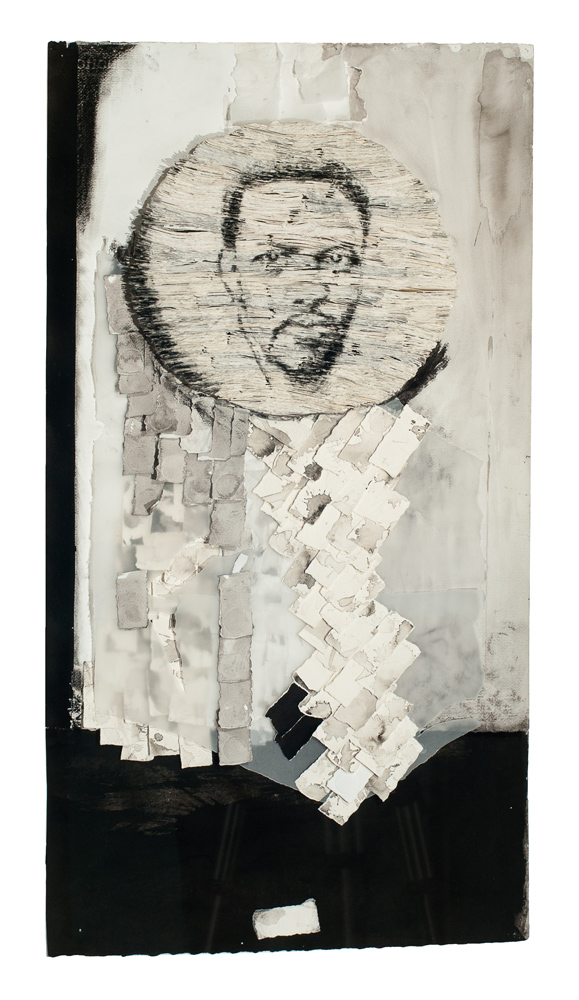There are many reasons to take the long way home. One might wish for a ‘scenic route’ or to avoid some potential pitfall or danger or just for the sheer pleasure of doing the unexpected and experiencing new horizons.
Maria van Rooyen’s first Cape Town solo exhibition takes this notion as it’s title but it seems that these works speak of all these possibilities in one.
Van Rooyen has been strongly influenced by Antjie Krog, Nosisi Mpolweni and Kopano Ratele’s There Was This Goat, a harrowing account of their researches into the seemingly garbled and confusing narrative of Notrose Nobomvu Konile at the Truth and Reconciliation Commission. Mrs. Konile’s account in the hearings dealing with the Gugeletu Seven incident, during which her son, Zabonke, was killed. What follows is a demonstration that testimony is complex, rich and essentialy untranslatable, whether from isiXhosa into English or from the pain experienced by a grieving mother to a legal panel. What remains is suggestion, allegory, stories and traces.
It is traces that Maria van Rooyen focuses on in all the works on the show; whether they be traces of the places visited, traces of the past or traces of the road well travelled. Her signature technique of constructing her large scale drawings of layers of rubbings made from various coins here is to evoke not only the excoticism of faraway spaces but also the significance of commerce in the construction of place and transformation of location and in the creation-and the alleviation-of misery and suffering.
VanRooyen’s traces go beyond the obvious and the linkages are subtle and draw from the South African (and wider) history, literature and culture. In the “Long Way Home” we are confronted with incarceration, enclosure, faded colonial glory and ultimately homecoming and release. For example in Sultan (the title is reference to the captive gorilla in the J.M.Coetzee’s Elizabeth Costello) we may note that the artist has utilized South African coins with a ship on as well as old Zuid –Afrikaanse Republiek coins showing the head of Paul Kruger. This reminds us that at the end of his life he was forced into exile (and eventual death) away from his beloved land as a result of British imperialism and greed. Similarly suggestive is her use of coins for Liberty in which we read the mottos of the USA (‘ In God We Trust’) and France ( Egality and Liberty) juxtaposed in her arm and torch, which leads the way and signals the light of a new home, which is made up of coins of Dubai showing an oil drill.
Maria van Rooyen’s work has a strong political consciousness but somehow even her sweeping landscapes (as in Victoria Falls and City Bowl) seem to be located in the personal. Her vantage point defines her vista but it’s fracturing by means of hundreds of elements that make it up also remind us of the shards that make up our individuality as well as the umbuntu concept that people become people because of others. The artist’s use of currency (and the literal and the figurative impressions left by its commerce) in the making her work perhaps seems to be odds with the subject matter. But this layering and texturing of money which resolves into the visual is also, I would argue, a political gesture: one that argues that our environment, history and location is constructed but nor defined by ‘the coin’ of a given economic and thus political regime.
In dealing with the subject matter van Rooyen imparts a strangeness and unfamiliarity to the quotidian, as if we arrive at it via a different route and thus see it afresh. Her Victoria Falls seem to be literally about to fall apart and the statue in Liberty is relocated to it’s philosophical and manufactured locus: the streets of Paris. In The Cruel Landscape (the title taken from a phrase in There was a goat) we see the back of a lone figure facing Cape Point. Perhaps this homecoming is ambivalent and still becoming, its completion to be realized still.
Notrose Nobomvu Konile’s testimony at the TRC was amongst the strangest heard. It seemed confused and often appeared off -the –topic of her son’s death. However, Krog and her collaborators demonstrated in the process of simultaneous translation, transcription and misreading what in fact made complete sense had become obscured through a lack of context and …..quite simply….understanding. Her testimony was about her coming full circle, of bringing her son’s body home and thus allow herself to carry on. Decades on, buried in the family village, she, and with Zabonke, have at last made the journey home……..









